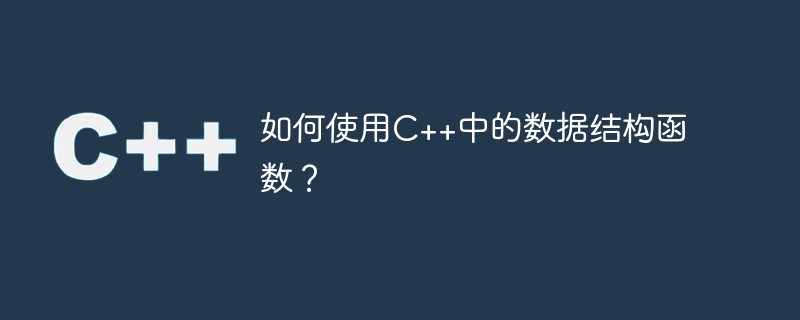Home >Backend Development >C++ >How to use data structure functions in C++?
How to use data structure functions in C++?
- 王林Original
- 2023-11-18 17:44:341463browse

How to use data structure functions in C?
Data structure is an important concept in computer science that involves how data is organized and stored for efficient access and manipulation. C is a powerful programming language that provides many built-in data structure functions that developers can use to create, manipulate, and manage different types of data structures. In this article, we will explore how to use data structure functions in C.
C provides many commonly used data structure functions, including arrays, linked lists, stacks, queues, heaps, trees and graphs, etc. By calling these functions, we can easily create and manipulate these data structures.
First, let's take a look at how to use array functions in C. An array is a linear data structure used to store a series of elements of the same type. In C, we can use array functions to create, access, and modify arrays. For example, use the std::array function to create a fixed-size array, and use the subscript operator [] to access and modify the array elements. In addition, you can also use the size function to get the size of the array. Here is an example:
#include <array>
#include <iostream>
int main() {
std::array<int, 5> arr = {1, 2, 3, 4, 5};
std::cout << "Array size: " << arr.size() << std::endl;
for (int i = 0; i < arr.size(); i++) {
std::cout << "Element at index " << i << ": " << arr[i] << std::endl;
}
arr[2] = 10;
std::cout << "Modified element at index 2: " << arr[2] << std::endl;
return 0;
}Next, let's discuss how to use the linked list function in C. A linked list is a dynamic data structure that consists of a sequence of nodes, each node containing data and a pointer to the next node. C provides the std::list function to create and operate linked lists. We can use the push_back function to add elements to the end of the linked list, the push_front function to add elements to the front of the linked list, and the pop_back function to delete elements at the end of the linked list. , use the pop_front function to delete the element in front of the linked list. The following is an example:
#include <list>
#include <iostream>
int main() {
std::list<int> linkedList;
// 添加元素到链表的末尾
linkedList.push_back(1);
linkedList.push_back(2);
linkedList.push_back(3);
// 添加元素到链表的前面
linkedList.push_front(0);
// 删除链表末尾的元素
linkedList.pop_back();
// 删除链表前面的元素
linkedList.pop_front();
// 遍历链表并打印元素
for (int element : linkedList) {
std::cout << "Element: " << element << std::endl;
}
return 0;
}In addition to arrays and linked lists, C also provides other important data structure functions, such as stacks, queues, heaps, trees, and graphs. Using these functions, we can create and manipulate these data structures to meet specific needs.
To sum up, the data structure functions in C provide developers with powerful tools to deal with different types of data structures. By using these functions appropriately, we can organize and manage data more efficiently, thereby improving program performance and maintainability. In actual development, we should choose appropriate data structure functions according to the requirements of the problem, and be proficient in their use in order to write high-quality code.
The above is the detailed content of How to use data structure functions in C++?. For more information, please follow other related articles on the PHP Chinese website!
Related articles
See more- C++ compilation error: A header file is referenced multiple times, how to solve it?
- C++ compilation error: wrong function parameters, how to fix it?
- C++ error: The constructor must be declared in the public area, how to deal with it?
- Process management and thread synchronization in C++
- How to deal with data splitting problems in C++ development

